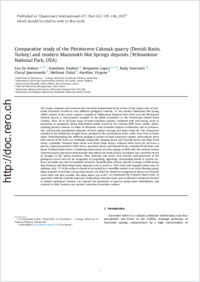Comparative study of the Pleistocene Cakmak quarry (Denizli Basin, Turkey) and modern Mammoth Hot Springs deposits (Yellowstone National Park, USA)
- Boever, Eva De Department of Geosciences – Geology, University of Fribourg, Switzerland - Department of Earth and Environmental Sciences, KU Leuven, Belgium
- Foubert, Anneleen Department of Geosciences – Geology, University of Fribourg, Switzerland
- Lopez, Benjamin Department of Geosciences – Geology, University of Fribourg, Switzerland - Université Aix-Marseille, CNRS, CEREGE, Aix-en-Provence, France - Total E&P Recherche Développement, Paris, France
- Swennen, Rudy Department of Earth and Environmental Sciences, KU Leuven, Belgium
- Jaworowski, Cheryl Yellowstone National Park Service, Yellowstone National Park, WY, USA
- Özkul, Mehmet Department of Geological Engineering, Pamukkale University, Denizli, Turkey
- Virgone, Aurélien Total E&P Recherche Développement, Paris, France
-
12.05.2017
Published in:
- Quaternary International. - 2017, vol. 437, Part A, p. 129–146
English
This study compares and contrasts the travertine depositional facies of two of the largest sites of travertine formation, located in very different geological contexts, i.e. the modern Mammoth Hot Spring (MHS) system in the active volcanic complex of Yellowstone National Park (USA) and the Pleistocene Cakmak quarry, a well-exposed example of the Ballık travertines in the extensional Denizli Basin (Turkey). New, 2D to 3D facies maps of both travertine systems, combined with microscopy, assist in proposing an integrated spring depositional model, based on the existing MHS facies model, understanding general controls on meter to kilometer scale travertine deposit architecture and its preservation, and provide quantitative estimates of facies spatial coverage and slope using GIS. The comparison resulted in the distinction of eight facies, grouped in five downstream facies zones from Vent to Distal Slope. Notwithstanding the different geological context of both travertine systems, observations show that several of the facies are strikingly comparable (draping Apron and Channel Facies, top-slope Pond Facies, crystalline Proximal Slope Facies and Distal Slope Facies), whereas other facies do not have a precise, exposed equivalent (Vent Facies, pavement Apron and Channel Facies, extended Pond facies and phyto Proximal Slope Facies). Combining observations of active springs at MHS with the Cakmak vertical travertine quarry exposures demonstrates that lateral and vertical facies transitions are a sensitive record of changes in the spring dynamics (flow intensity and paths) that become well-preserved in the geological record, and can be recognized as prograding, aggrading, retrograding trends or erosive surfaces, traceable over tens to hundreds of meters. Quantification of facies specific coverage at MHS shows that Proximal and Distal Slope Facies deposits cover as much as ∼90% of the total mapped surface area. In addition, only ∼7% of the surface is found to be marked by a waterfilm related to an active flowing spring. Slope statistics reveal that strong slope breaks can often be related to transgressive Apron and Channel Facies belts and that variable, but steep slopes (up to 40°) are dominated by Proximal Slope Facies, in agreement with the Cakmak exposures. Integrating travertine facies and architecture of deposits formed in distinct geological contexts can improve the prediction of general spring facies distributions and controls in other, modern and ancient, subsurface travertine systems.
- Faculty
- Faculté des sciences et de médecine
- Department
- Département de Géosciences
- Language
-
- English
- Classification
- Geology
- License
-
License undefined
- Identifiers
-
- RERO DOC 288918
- DOI 10.1016/j.quaint.2016.09.011
- Persistent URL
- https://folia.unifr.ch/unifr/documents/305516
Statistics
Document views: 141
File downloads:
- pdf: 332
